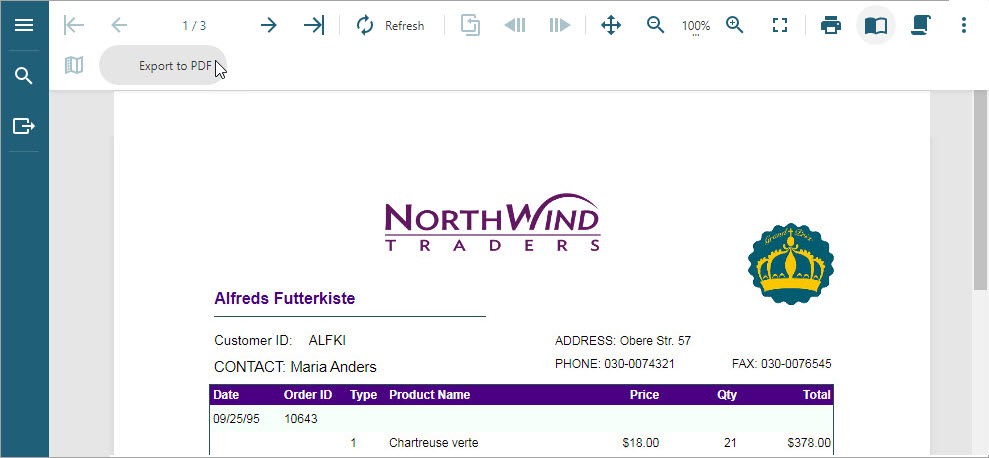- Introduction
- Report Readers
- Report Authors
- DevOps
-
Developers
- Quick Start
- Breaking Changes
- ActiveReports Version Compatibility and Migration
- License ActiveReports
- Configure ActiveReports Using Code
- Work with Reports using Code
- Report Parts
-
Create Designer and Viewer Applications
- .NET Viewer Application
- Web Viewer and Web Designer Middlewares
- Js Viewer Application
- ASP.NET WebViewer Application
- Blazor Viewer Application
- WebDesigner Application
- Blazor WebDesigner Application
- End User Report Designer in WinForms Application
- Themes in WebDesigner and Js Viewer Components
- Role Based Authorization with JWT
- Extensibility in ActiveReports
- External Customizations in ActiveReports
- Export Reports
- Print Reports
- Plugins Development
- Samples
- Troubleshooting
Customizing the WebViewer UI
You can customize the WebViewer interface using JQuery methods. WebViewer control adds JQuery library in page scripts. Use the code in this walkthrough to add a button on the toolbar and add a client side PDF export implementation.
When you complete this walkthrough you get a WebViewer that looks similar to the following at run time.

Load an ActiveReport to the Web application
- Create a new Visual Studio ASP.NET Web Forms application.
- Install MESCIUS.ActiveReports.Web package. Go to Tools > NuGet Package Manager > Manage NuGet Packages for Solution..., browse for the package and click Install.
- In Solution Explorer, right-click the project and select Add > New Item.
- Select WebForm and click Add.
- Go to the Design view of the newly added WebForm.aspx and drag and drop the WebViewer control to the WebForm designer. The default viewer type is HTMLViewer.
- Load a report in the WebViewer by setting the ReportName property.
type=note
Note: You may load any report, section or page in the HTMLViewer viewer type of WebViewer. See ASP.NET WebViewer Application for information on loading a report.
Add the jQuery library to the Web application project
In the Source view of the WebForm.aspx file, add the following code.
<script src="https://code.jquery.com/jquery-2.1.4.min.js"></script>
Access the WebViewer view model
The HTML WebViewer is created using the MVVM pattern that provides a view model which does not depend on the UI. The code can access the Viewer's view model and bind the custom UI to it by using well-documented properties and methods. For MVVM support, the code can use knockout.js which is the standard MVVM library for JavaScript. Knockout.js provides declarative bindings, observable objects and collections in HTML markup.
Follow the steps below to access the ViewModel.
In the Source view of the WebForm**.aspx** file, add a <script> tag.
Add the following Javascript code for document's Onload event handler and WebViewer's Loaded event handler that gets fired when the UI is rendered on the Html Page:
<script> function viewer_loaded() { }; function document_onload() { }; </script> ... <body onload="document_onload()">Add the following Javascript code inside the viewer_loaded event handler to access WebViewer's view model:
function viewer_loaded() { var viewModel = GetWebViewer('ArWebViewerDiv_WebViewer1'); };Add the following Javascript code inside the document_onload event handler to bind WebViewer's Loaded event to client side viewer_loaded event:
function document_onload() { $('#WebViewer1').ready(viewer_loaded); };
Add a button to the WebViewer toolbar
In the Source view of the WebForms.aspx file, add the following Javascript code inside the viewer_loaded event handler to access the WebViewer toolbar. Lets add the custom button in the toolbar - an export button and add PDF export functionality to it.
function viewer_loaded()
{
var viewModel = GetWebViewer('ArWebViewerDiv_WebViewer1');
var pdfExportButton = {
key: '$pdfExportButtonKey',
text: 'To PDF',
iconCssClass: 'mdi mdi-file-pdf',
enabled: true,
action: function (item) {
console.log('Export to PDF function works here');
},
onUpdate: function (arg, item) {
console.log(The Viewer UI was updated, check/update button state here');
}
};
viewModel.toolbar.desktop.addItem(pdfExportButton);
};
The complete code for WebForm1.aspx in the Source view is as shown:
<%@ Page Language="C#" AutoEventWireup="true" CodeBehind="WebForm1.aspx.cs" Inherits="WebApplication1.WebForm1" %>
<%@ Register assembly="MESCIUS.ActiveReports.Web" namespace="GrapeCity.ActiveReports.Web" tagprefix="ActiveReportsWeb" %>
<!DOCTYPE html>
<html xmlns="https://www.w3.org/1999/xhtml">
<head runat="server">
<title></title>
</head>
<body onload="document_onload()">
<form id="form1" runat="server">
<div>
<ActiveReportsWeb:WebViewer ID="WebViewer1" runat="server" height="466px" width="667px" ReportName="AllCustomers.rdlx">
</ActiveReportsWeb:WebViewer>
</div>
</form>
<script src="https://code.jquery.com/jquery-2.1.4.min.js">
</script>
<script>
function viewer_loaded() {
var viewModel = GetWebViewer('ArWebViewerDiv_WebViewer1');
var pdfExportButton = {
key: '$pdfExportButtonKey',
text: 'To PDF',
iconCssClass: 'mdi mdi-file-pdf',
enabled: true,
action: function (item) {
console.log('Export to PDF function works here');
},
onUpdate: function (arg, item) {
console.log('Something in viewer was updated, check/update button state here');
}
};
viewModel.toolbar.desktop.addItem(pdfExportButton);
};
function document_onload() {
$('#WebViewer1').ready(viewer_loaded);
};
</script>
</body>
</html>
To remove a button from the viewer's UI
function viewer_loaded()
{
var viewModel = GetWebViewer('ArWebViewerDiv_WebViewer1');
...
viewModel.toolbar.desktop.removeItem($newButtonKey); //(key of the button)
};
type=note
Note:
- Replace 'WebViewer1' in the code snippets above, with the actual ID of the WebViewer control in your application.
- When trying to get access of a WebViewer using GetWebViewer method, we should add 'ArWebViewerDiv_' prefix before the WebViewer ID.
- In case you provide report name which contains special symbols (like backslash '\'), e.g. webViewer.ReportName="Folder\Report.rdlx", you need to update the web.config file to allow such characters. Otherwise, "Report not found" error occurs. Please see Troubleshooting on resolving this issue.
- If your report has parameters, you can choose to set the parameters pane position to the top of the viewer using the ParametersPanelLocation to 'Top'.


